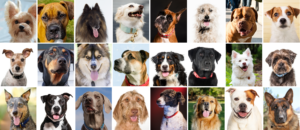To best understand this article in the context of the Breeds and Behavior literature, please see National Canine Research Council’s complete analysis here.
Hall, N. J., Glenn, K., Smith, D. W., & Wynne, C. D. L., (2015). Performance of Pugs, German Shepherds, and Greyhounds (Canis lupus familiaris) on an odor-discrimination task. Journal of Comparative Psychology, 129(3), 237-246. doi: https://dx.doi.org/10.1037/a0039271
National Canine Research Council Summary and Analysis:
This study is included because behavior was in fact objectively assessed. In contrast to the bulk of the literature which relies on owner surveys, Hall, Glenn, Smith, & Wynne (2015) measured dogs of three different breeds (German Shepherds, Pugs, and Greyhounds) on an odor-discrimination task, and in doing so exposed some assumptions and biases made about breeds and their abilities. They note that German Shepherds, hounds, terriers and Labradors are often used in scent-detection work, while toy breeds and brachycephalic dogs are avoided. They suggest that these choices may not be scientifically based, but rather descend from tradition and opinions about dog breeds. Thus, they chose both commonly used odor detection dogs (German Shepherds) and dogs that are not commonly used (Pugs because they are brachycephalic, and Greyhounds because they are classified as sighthounds, which carries the stereotype that they rely more on sight than scent). The authors hypothesized that, if popular opinions are true, German Shepherds would learn the odor-discrimination task faster than Greyhounds or Pugs, and that differences in ability would be further evident when the target odor solution was diluted.
Subjects were recruited via email solicitation (breed club listservs and a participant pool), flyers, and word-of-mouth. Dogs were required to be purebred; this was confirmed by owners indicating they had purchased their dog from a breeder or adopted from a breed-specific rescue, as well as visual identification by the experimenters. While not as conclusive as a pedigree, this means of breed identification would appear to be reasonably reliable. Thirty-one dogs met inclusion criteria (10 German Shepherds, 11 Pugs, and 10 Greyhounds), but 10 subjects failed to meet motivation criteria (9 Greyhounds and 1 Pug) and thus could not complete the odor discrimination task. The authors did not speculate regarding reasons for the Greyhounds’ lack of motivation (either rejecting the freely offered food from an experimenter or rejecting visible food placed on the bucket that the dogs were trained to dig in), but it is worth noting that Greyhounds raised in a racing environment have profoundly different developmental and socialization opportunities than do dogs raised in pet homes, and that environmental effects must always be a primary factor in comparing the behavior of any dogs, even at the individual level.
Prior to experimental trials, the dogs were trained to alert to a target odor (S+) buried in a bin of pine shavings. During testing, two bins were present: the target odor (S+) and a control (S-) of mineral oil. They used mineral oil because it was later used to dilute the target odor (S+).
The Pugs and German Shepherds both improved over sessions, indicating that they had learned the task. The Pugs consistently outperformed German Shepherds, and this trend continued for the dilution trials.
Hall et al. (2015) were careful to include controls and checks for experimenter bias. Using mineral oil as both the non-target odor and the dilution solution served two purposes; first, it ensured that the dogs were not simply averse to the non-target odor, and second, it showed that the dogs were in fact discriminating between odors. In addition, the authors designed the study such that the assistant (the person indicating when a choice was made) was blind to which bin was correct. The experimenter, who reinforced the correct choices with a treat and praise, stood in a neutral position equidistant from the bins and did not face the bins or look at the dog until the assistant verbally indicated that a choice had been made. This was meant to reduce unintentional cues from the experimenter. As a second check, another observer scored a subset of the recorded trials and there was high agreement between the two assistants (K = 0.87). Another control included trials in which the non-target odor was present in both bins (without the S+), with one bin pre-determined to be “correct.” This served as another check for unintentional cues from the experimenter.
In an attempt to rule out motivational or trainability differences between the Pugs and German Shepherds as reasons for the differing performance, the experimenters repeated the training process, this time substituting a visual discrimination (between a larger and smaller version of otherwise identical cups) and found no performance difference between the German Shepherds and Pugs. However, this does not wholly rule out motivation as the difference, which could still be attributed to simply finding one task itself more motivating, rather than physically easier to perform.
Because the results of this study are so unexpected, it may be dismissed as a silly anecdote of Pugs beating German Shepherds at an odor task. However, reducing it to a funny story is a mistake. It is important to consider the underlying implications of this study. Because of tradition and popular perception, some breeds, such as German Shepherds, are favored for scent detection work while other breeds, like Pugs, are avoided. Yet, this study’s results completely contradict this convention. If this small study can be replicated with larger samples, such findings demand attention, and careful consideration of other behaviors, traits, and abilities that we unquestioningly assign to breeds.
Abstract and Link to Purchase Full Text of the Original Article:
https://www.ncbi.nlm.nih.gov/pubmed/26010195
Page last updated July 16, 2019





